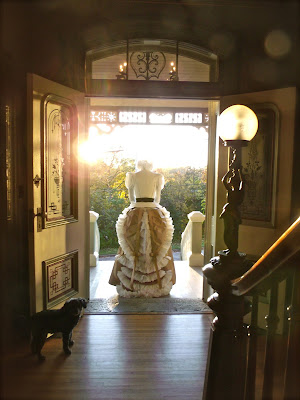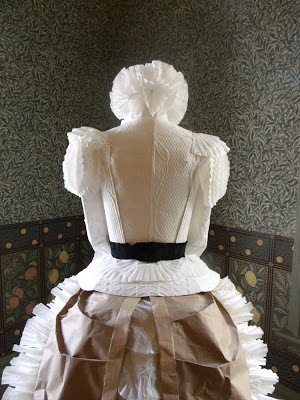 |
| Pears soap advertisement from The Canadian Magazine, December 1911 |
I remember when we first saw the bathroom of the Dusty Victorian four years ago, we went "Ooooo" and "Ahhhh". We hear these same expressions from our guests now that we operate a B&B. The previous owner put a lot of effort and expense into recreating the charms of yesteryear without compromising on modern conveniences.
Recently, I've been focusing on the beautiful embossed wall covering in the bathroom, an element that is serving as inspiration for making my homemade, natural luxury soaps.
We found leftover, unpainted sheets of this wall covering in the attic. I sectioned off the areas that were of interest.
All four could make excellent mold patterns for my soaps.
I constructed my molds to fit the size of the wall covering patterns. The wooden mold served in casting the silicon mold, and will be reused later in making my soap.
Two sides are on hinges for easy removal.
I made two different sizes which can fit four patterns.
I purchased food grade liquid silicone, lined my molds with wax paper and proceeded with casting. This technique of pouring the silicone from higher up eliminates any bubbles that can ruin the silicone casting.
It's a slow process, but it works.
I have a perfect bubble free silicone mold once it's cured.
To make my guest soaps I used 100% natural soap bought at St Marys' Village Craft and Candle,
a great store located a few minutes walk from the DV.
To make my guest soaps I used 100% natural soap bought at St Marys' Village Craft and Candle,
a great store located a few minutes walk from the DV.
A rich Shea Butter basic soap is the one I chose for this pouring. I'm making it even more luxurious by adding a little bit of paprika for colouring, almond oil and almond extract, as well as Ylang Ylang aromatic essential oil. The additive will be mixed in once the soap has melted and before it's poured into the mold. Unlike the silicone pouring, I make sure I'm very close to the bottom of the mold when pouring my liquid soap so as to avoid creating splashing bubbles.
Placed outside in this winter weather, the soap hardens fast.
After a couple of hours, the soap has set. It's removed from its mold and the silicone is peeled away, revealing the low-relief image of my pattern.
I clean up the edges of the soap slab with a sharp knife, keeping the slivers for a next melting.
It's now ready to cut up in more practical sizes.
These little guest soaps are approximately one ounce, which can last three to four washings. The majority of our B&B guests stay one night, but are encouraged to bring their little soap back home with them if they want.
The soaps will be left to dry and harden for a week or two. The dryer the soap, the longer it last.
Note: This post is not a DIY tutorial - I leave that to the experts. Many hours were spent researching silicone mold making and soap making techniques, through books, the internet and many video tutorials. I just want to share my experience and perhaps plant a creative seed. I'm pondering making my own basic soap from scratch using olive oil, a soap also known as castile soap.The soaps will be left to dry and harden for a week or two. The dryer the soap, the longer it last.
I have a lot to learn about soap making, but the 'melt and pour' technique is the easiest and is a guaranteed success. I love the fact that my family and our guests are using a 100% natural soap. No chemicals, no artificial colours or synthetic scents. They are entirely bio-degradable, so won't harm the environment. And they are gentle enough for the face. When my garden yields its bounty, I will add beneficial dried herbs and petals to the soaps to create different aromas, colours and effects. My vegetarian daughter is very pleased that no animal by-products are present in our soaps. I also love the fact that these soaps were created using decorative details unique to the DV's bathroom.
 |
| Le Calice Castile Soap advertisement from The Canadian Magazine, December 1911 |






















































